Within a Close Circle. George Kiesewalter Interviewed by Sasha Obukhova
Date
A talk about unofficial Moscow art scene of 1970s and 1980s with one of its principal chroniclers.
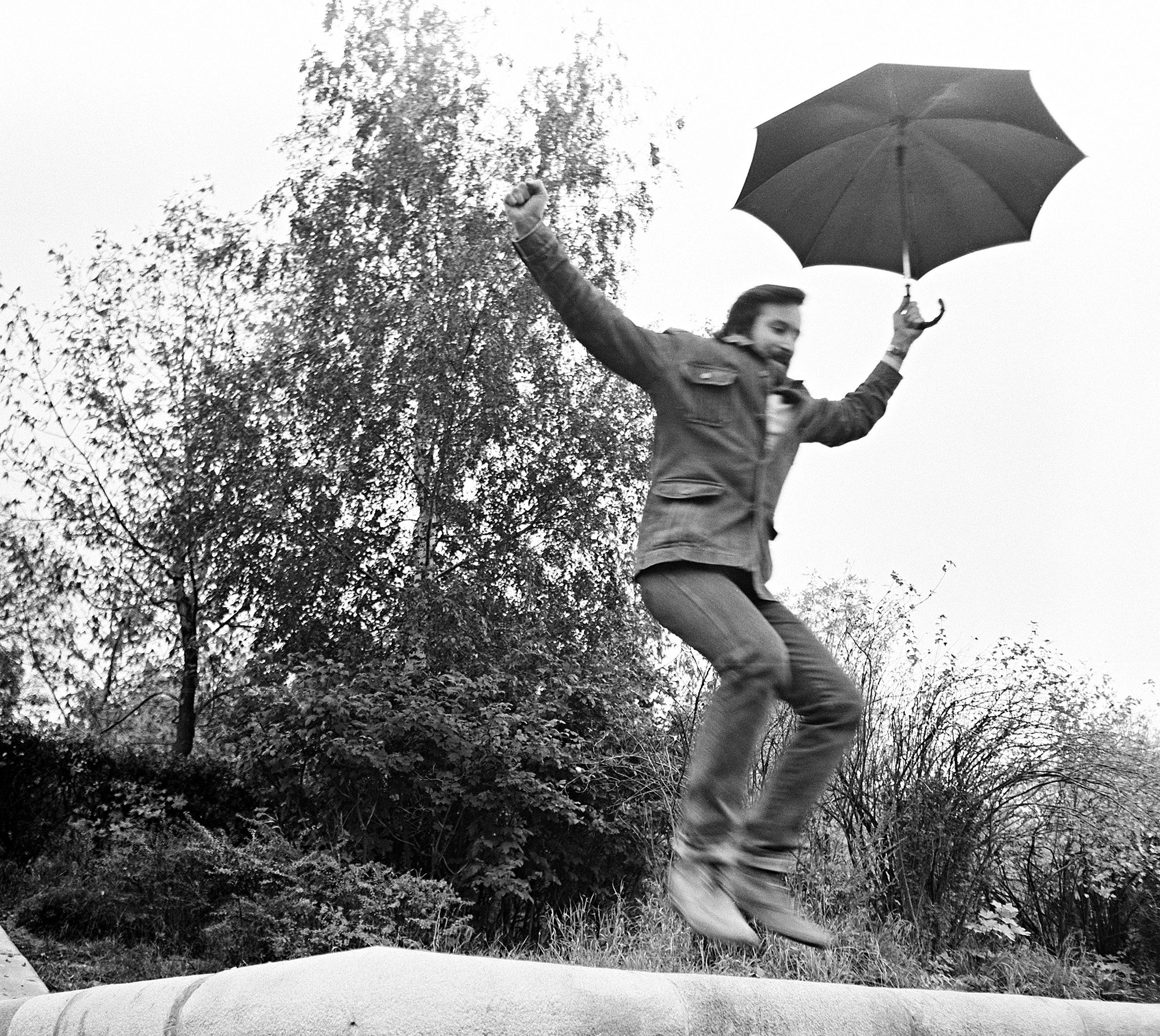 Love me, love my umbrella series
Love me, love my umbrella series
(1984). George Kiesewalter
Photo: Francisco Infante
Sasha Obukhova: How did you, a philology student, find yourself in a group of Moscow poets and artists?
George Kiesewalter: From 1969 I used to go on holiday with my family to Käsmu in Estonia, a village which was then located in a closed border zone. I was a teenager. My parents would sometimes point out the group of youngsters that gathered in a local café. They were older than me, around 20 to 25. “And that young man,” they said, “is a poet.” That's how I first came across Lev Rubinstein. The age difference was big: at that moment he was of no interest to me, and I was of no interest to him. In the same way they pointed out Anastasia Tsvetaeva,[1] and then a year later I got to know Evgenia Zavadskaya[2] and other members of the Soviet artistic and academic scene. Recently, in conversation with Andrei Monastyrsky, it turned out that he was also in the same crowd, but I didn't notice him back then.
Several years passed, and we all got to know one another; we started to hang out. In the summer of 1974 I got to know Irina Nakhova and Valery and Rimma Gerlovina. From that point on, along with Lev Rubinstein and Andrei Monastyrsky, we began to mix very closely in Moscow.
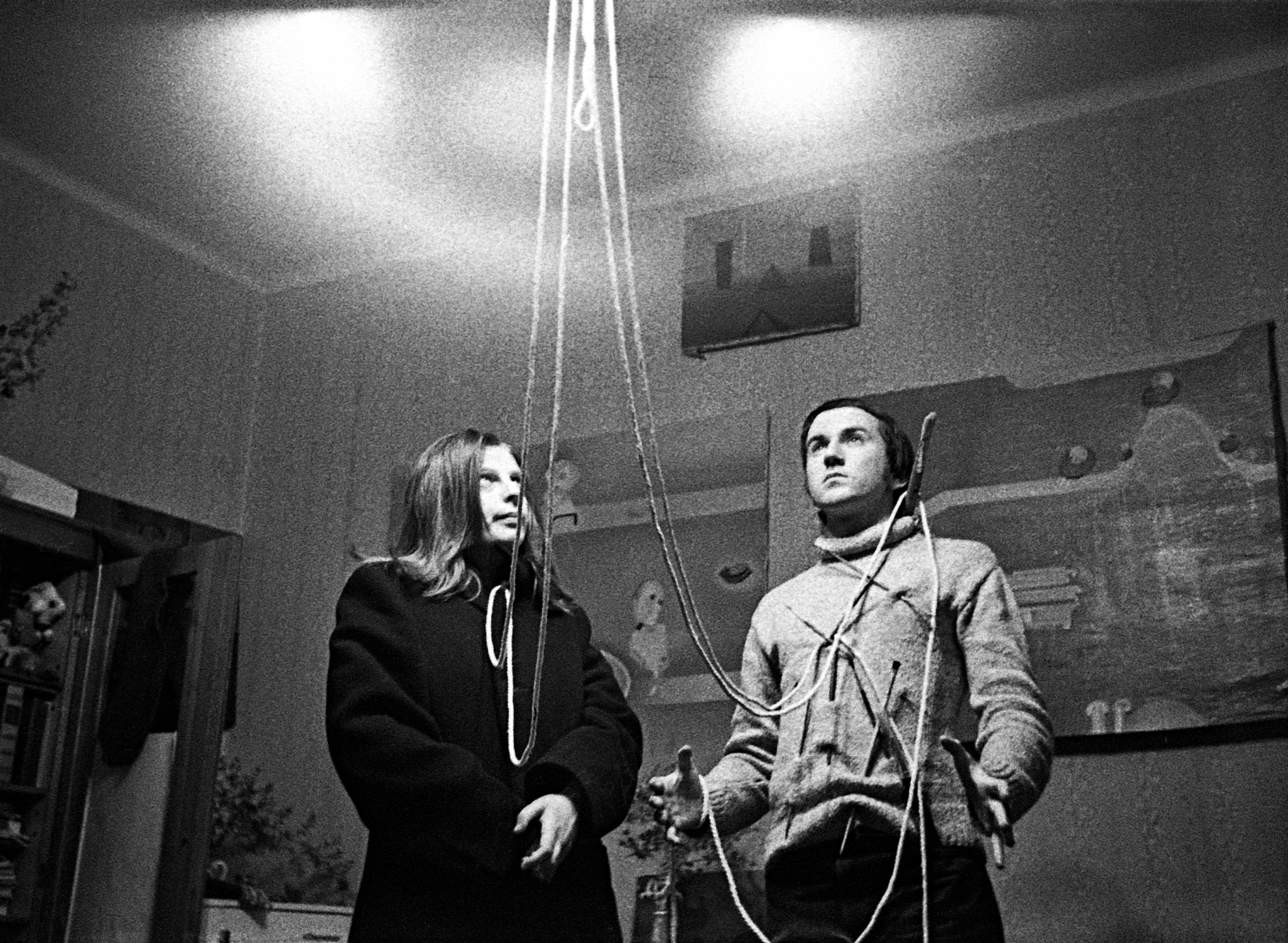 Irina Nakhova and George Kiesewalter during a happening at Andrei Monastyrsky and Irina Nakhova’s apartment.
Irina Nakhova and George Kiesewalter during a happening at Andrei Monastyrsky and Irina Nakhova’s apartment.
Moscow, 1974.
© George Kiesewalter
S.О.: Did you have an interest in non-standard practices in poetry and art then?
GK: At some point I became really interested in Eastern art, and I even planned to enroll at Moscow University’s Institute of the Countries of Asia and Africa (ICAA). I had lots of relatives and friends there, but nobody in my family had bothered to give me the “appropriate” ideological foundation. I joined the Komsomol late, only in 10th grade. I really didn't want to, although there was pressure to join from 7th grade. The year that I was to enroll at the ICAA they introduced two years’ membership of the Komsomol as an obligatory requirement, and I didn't have that. So they didn't let me in. Now I can see that was probably for the best.
Basically, I was interested in strange Buddhist art. As a schoolchild I attended the Young Art Historians’ Club at the Pushkin Museum. The whole of my childhood was spent visiting theaters, the Conservatory, painting classes with my aunt—an artist—and writing stories. We lived downtown, so everything was at hand. I had a “classical background,” but as time passed I became interested in different means of expression. I had an unusual view of the world, and in Soviet collectives I was always the black sheep. The summer discussions in Käsmu fell on fertile ground. I remember walking in the forest, and Monastyrsky, with a siren’s charm, telling me about his poetry, where the most important thing for him was the empty space between stanzas. Valeriy Gerlovin was also there, describing his abstract paintings. I think that was the same year Alexander Melamid and Vitaly Komar appeared in Käsmu.
SO: How did your group develop from the summer of 1974 to March of 1976, when the first action of the Collective Actions group that you took part in took place? What was the focus of your discussions? What led to the creation of joint works?
GK: In Moscow we began to meet up with increasing frequency, and my circle of acquaintances continually expanded. I started visiting artists’ studios, although more often than not these “studios” were actually apartments, or even a room in a communal apartment. We were always hanging out together. Nakhova, Monastyrsky, and I might get together, and then go to see Nikita Alexeev in Khovrino, then on to an apartment exhibition. We might spontaneously decide to take a train to Leningrad, to get to know some local artists. It was a very busy time. There was always something happening—apartment exhibitions, actions by Gnezdo (Nest) group and Komar and Melamid, etc. Our circle wasn’t very closely linked to Komar and Melamid’s Sots Art. It was interesting, but we always wanted to rise above Soviet reality to the “Magic Mountain.”[3] We looked to Zen Buddhism, German Romanticism, and music.
I listened to all sorts of music. We could buy some 20th-century classical music in the shops, and our foreign friends would bring us records. I was interested in Stockhausen and Schoenberg, along with The Doors and Canned Heat. We would often go to the Electronic Music Studio at the Scriabin Museum on the Arbat or listen to recordings of Alexandre Rabinovitch-Barakovsky[4] brought from France. At that time, in different places, pianist Alexei Lyubimov and percussionist Mark Pekarsky began performing concerts of contemporary classical music. We would go to see violinists Gidon Kremer and Tatiana Grindenko. We had friends at the Conservatory who would keep us informed. Moscow at that time lived on the grapevine. There were frequent readings. Lev Rubinstein started his conceptual project Program of Works in 1975, which over time developed into readings/performances of his “catalogue cards.”[5] It was an amazing time, with evolutionary activities in totally different spheres of culture. The most varied people would meet up and hang out. I carried on visiting studios, saw who was doing what. My first year was more about studying, although soon I began to work as an artist.
SO: Who did you go and visit back then?
GK: A wide range of artists: Eduard Steinberg, Viktor Pivovarov, Vladimir Yankilevsky, Yuri Sobolev, Erik Bulatov, Oleg Vassiliev, Sergei Shablavin. And, of course, Ilya Kabakov. My first visit to him was fairly official: we looked at his albums, drank some tea and left. But even then Kabakov's work made a deep impression on me. What he was doing was close to my nature, and even to what I'd painted in childhood.
We hung out with artists such as Sergei Bordachev, Armen Bugayan, Irina Pivovarova, and Andrei Abramov. I got to know Abramov through Valeriy Gerlovin, and later we became friends. The mid-1970s were a multi-layered time, when Surrealism, sickly sweet religious pictures, and derivative abstract works were all still popular, but intellectual, conceptual art had already begun to appear. Everything intersected, boiling in the same pot. Even so, we formed an inner circle.
SO: How did your take on the different elements in the Moscow underground develop, for instance on Sots Art, or what the 1960s generation was doing? What did you think about those who had “unofficial” status?
GK: Having unofficial status created an aura, so at first I approached artists like Oskar Rabin, Vladimir Nemukhin, Dmitri Plavinsky, and Dmitry Krasnopevtsev with incredible piety. Literally a half year later, after reading Western art magazines—I subscribed to Projekt, but saw Artforum, Flash Art, and others—I began to realize that the 1960s generation had been left in the past. The work of certain young artists, such as Gnezdo, also wasn't received with an unambiguous “hurray,” although they had a lot of stuff that was interesting. Back then, any work that took you away or freed you from the gray world of the Soviet prison was valued. Kabakov talks about that in his memoirs. Why was everyone friends? Because there was a circle of people who in general understood one another, they had a shared tendency to idealize freedom and art, although at the same time they didn't always share each other's aesthetic outlook. For example, the work of Eduard Steinberg or Vladimir Yankilevsky was astonishing, but it was distant. At that time I really liked Nikita Alexeev's experiments. We were all looking for our own style at the time, trying different materials, techniques, forms. In the 1980s he “found himself” and immediately lost a certain sharpness. Don’t forget that one's evaluation of any artist changes with time, negatively or positively. It's a complex dialectic.
SO: There was Evgeny Shiffers,[6] who had a lot to say about Shvartsman, Steinberg, and Yankilevsky.
GK: We somehow missed out on Shiffers. Even Anatoly Zhigalov, with his mysticism—he was working as a translator at the Patriarchate—was closer to us. We didn't want anything to do with the dark side of metaphysics, even though the 1970s were religious, and we went to church together. Our religion was probably an unconscious form of protest. Later, in the 1980s, all that disappeared.
In 1976, at Shablavin's, I met Boris Orlov and Dmitri Prigov. Dmitry's poems made a strange impression on me at first. We exchanged glances and shrugged. Basically, the satirical “understandability” and “accessibility” of Prigov's poetry at that time didn't interest me, so I didn't mix with him any more in the 1970s.
In 1977, I went to work in Yakutia, and I missed Alexander Chachko's[7] first seminars.
SO: Going back to 1974–1975, a couple of notorious events took place immediately after your introduction to that circle: the Bulldozer and Izmailovo exhibitions. Did you not want to take part in the latter? It was approved by the authorities, and anyone could show their work.
GK: Back then I didn't have anything to show. I was just looking. Actually, I had a fairly long period of self-discovery. I always thought that what everyone else was doing was much better, and I was shy. In February 1975, there was an exhibition at the Beekeeping Pavilion at VDNKh. I remember I was impatient to get there, but I didn't take my camera. I think I didn't understand what I might see there, and what might happen. Maybe it was something else: when an event was really important, or gave entirely new impressions, I would forget about the camera. But I shot the legendary exhibition at the House of Culture at VDNKh.[8]
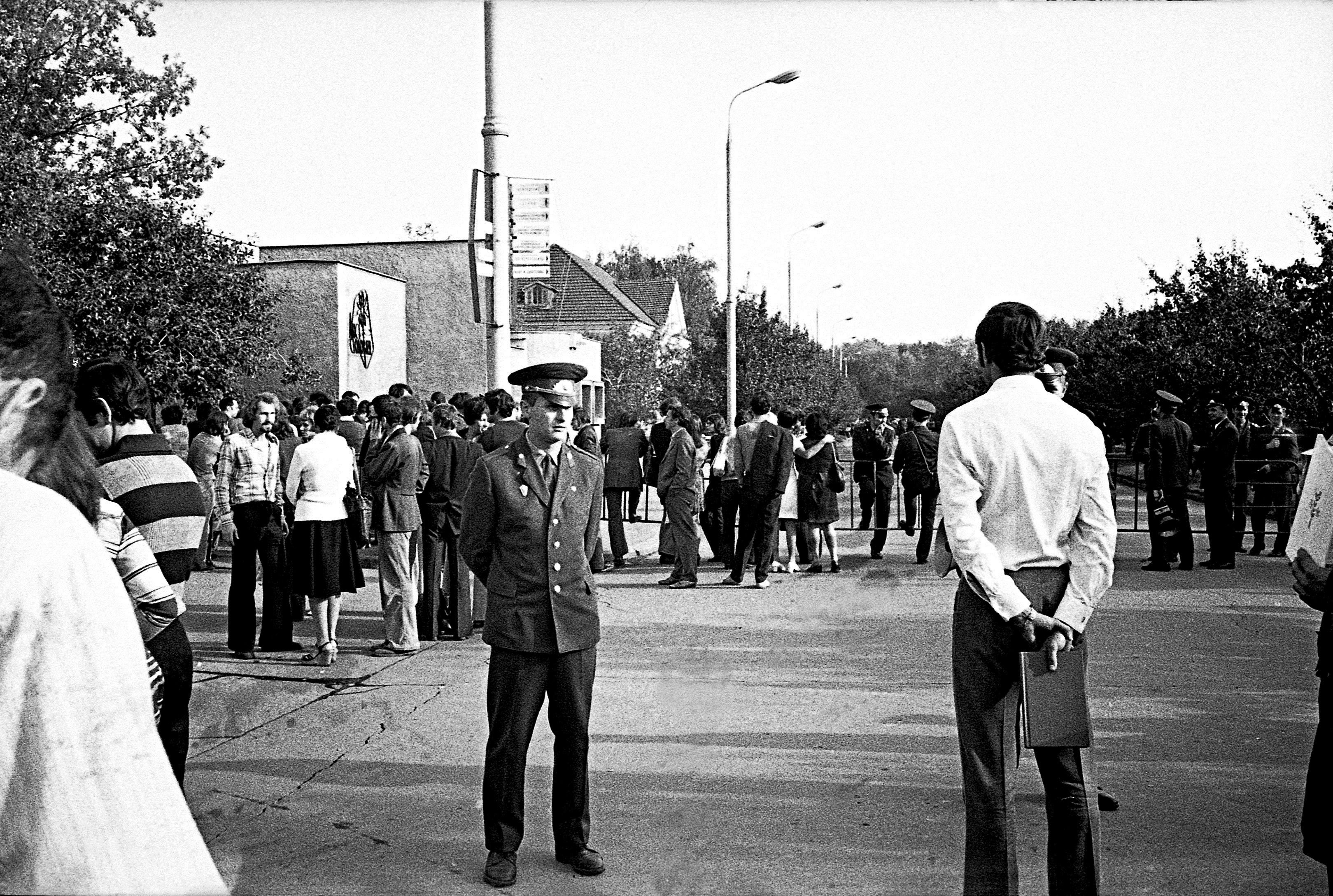 People lining up for the exhibition of Moscow unofficial art at the House of Culture at VDNKh.
People lining up for the exhibition of Moscow unofficial art at the House of Culture at VDNKh.
Moscow, September 1975
© George Kiesewalter
SO: Often an artist documenting a process perceives the act of documentation as part of the artistic project. Vadim Zakharov is a good example. Then there are artists for whom the photograph isn't about archiving the everyday, but an artistic task. Here I'm thinking of Igor Makarevich, who has long experimented with photography as a technology connected with contemporary art. What role did the camera play for you? Was it a device for documentation, a tool, in the same way as paint and canvas, or just a hobby?
GK: Probably the second option. It was an integral part of my life. My first camera was given to me by my father in 6th grade—it was a World War II trophy, a plate camera, 6x9, and I went around Moscow's streets with it for some time. I shot old buildings, then developed the glass plates in the bath in my communal apartment and made contact prints. Back then photographic plates were sold were only available with a single photosensitivity—equivalent to 100 ASA, according to the state standard—which really narrowed the range of things they could be used for. I tried to shoot people. Sometimes it worked. That's how I studied. A year later, a different camera arrived—a Smena-7. At first I photographed relatives, then friends at school. It wasn't too bad. I enjoyed the process. At the time, I didn't think whether I was documenting anything. They were my friends, my life, the here and now—spontaneous, mechanical photography. In the 1970s, I had absolutely no thoughts of preserving anything for posterity. I shot our life, in which photography played a part. Now I regret that certain films were lost. I would often chop up developed film and put the pieces in books so that they'd straighten out. I think that my parents, when I was away, found them and got rid of them, not knowing whose they were. I came home and found some of the film was missing. We only started seriously documenting anything at the end of 1980, when we started collecting materials for the Moscow Archive of New Art (MANI).[9]
SO: How about the actions of the Collective Actions group?
GK: At first there was no Collective Actions, we just started working together. Three years later, we began to understand that we had to document everything and put together textual materials. At the first action, Appearance,[10] I was one of the only photographers, and the visual element was really weak, which was something that we partly strove for—use of minimal resources to convey a simple, non-aesthetic category. But what could you shoot during a performance? People came out of the forest, walked across a field, the public saw this, received their certificates, and that's it. I stood more or less in one place and shot. Later, following advice that I'd read somewhere that you should wash the film in warm water, I went and washed the shots from the Lieblich action[11] in water that was too hot and ruined them. After I'd left for Yakutia, Igor Makarevich appeared, and substituted for me for three years. Andrei Abramov took photographs at our actions too.
SO: Later, even the most minimalist actions were preserved in an endless series of photo-documentations, for example, Monastyrsky's article Seven Photographs, where one and the same barren landscape with a forest on the horizon is repeated.[12]
GK: That was at the beginning of the 1980s. In the 1970s a lot of things were organized in a fairly amateur manner: the attitude was “now we'll just go there and do photographs,” but what was happening had a purely existential significance. It was a “life-in-play” (remembering Herman Hesse’s The Glass Bead Game, which we all loved back then). We (or at least I) did not recognize the importance of what we were doing. We were amusing ourselves and doing “something strange.” Nevertheless, I wanted to work with good equipment and, on my return to Moscow at the end of the 1970s, I improved my technical arsenal using money I’d saved while working in Yakutia. In the 1980s I started using a Zenit E and a Pentacon 6x6. Of course, by today's standards, the Zenit was a horror, but back then it wasn't cheap—is certainly cost more than one pay packet. However, it was a camera you could use German Praktika lenses with, which were available in second-hand stores. That significantly broadened the creative opportunities of photographers and gave them a chance to experiment. Soviet cameras and lenses weren't that bad, but it was hard to find them and they weren't cheap. The Pentacon had great lenses, but it had one drawback–the film-winding mechanism would periodically break, and the shots either overlapped or you ended up with huge gaps on the film. I always did the developing and printing myself. By 1980 I already had a studio in a communal apartment on Bolshaya Polyanka Street, which I used as a photo laboratory. At first I mixed with different “professionals,” and some of them—entirely sincerely, I believe—often gave me fairly idiotic advice, for instance developing using Metol and sulphite. I tried that. It worked, but there's a lot of contrast without any half-tones. In 1983, I swapped two of my paintings for a Nikon FM2 with lenses–that was a big step forward. In 1980 I bought a Polish Crocus photographic enlarger, which, although far from perfect, was a great leap forward in comparison with the U-2 enlarger which I'd had since the 1970s. It allowed me to create high-quality prints. Over time, I changed the lens to good lanthanum one.
 Andrei Monastyrsky and George Kiesewalter. Moscow, 1980.
Andrei Monastyrsky and George Kiesewalter. Moscow, 1980.
© George Kiesewalter
SO: There is a series of photographs from the exhibitions at the APTART Gallery. For a long time, starting from the early 1990s, I couldn't find out from anyone who the photographer was. Many photographers back then—Valentin Serov, Igor Palmin, Oleg Kaplin—always signed their prints, but you didn't. Why not?
GK: In the 1970s I signed most of my prints with a stamp with my surname on it. In the 1980s I somehow didn't have time to think about that. I had to shoot everything fast and print it for the archives, but the authorship wasn’t important. Perhaps there was also a sense of a “necessary anonymity”—what if the KGB somehow got hold of the documentation?
SO: Your exhibition at Garage[13]was, in some sense, about the return of authorship, because many of the events were only captured thanks to your efforts. Vadim Zakharov has some of your negatives, as do Ilya and Emilia Kabakov, and you are now gathering them from private archives.
GK: Yes, and now some people refuse to give back my negatives! Or they’ve been lost. I already had a bad experience in 1977, when I sent negatives to the Venice Biennale,[14] and they were all subsequently lost. There were huge prints on display there, which was like a miracle for me—shot on a Smena, but here they are enlarged to a meter!
SO: But there was a fairly laid-back approach from the outset.
GK: Of course, it's criminal carelessness. But those negatives were already out of my hands, I couldn't control them. And back then the attitude was more about making work than preserving it. For me, a lot of it was routine: I might throw away something that others would consider a masterpiece, which would be shown at all sorts of biennials.
SO: So, in effect, the documentation runs in parallel with the artistic work. That's a fairly distinctive approach to what we call Conceptualism. The Moscow school of Conceptualism is probably the only case when a time-consuming practice is viewed as a pleasant way to pass the time, rather than as a part of a global series of works.
GK: I viewed the documentation as an activity that was in parallel with and secondary to my work in art. The exhibition APTART Behind a Fence[15] included my photographic work Fragmentary Self-Portrait (1983). Then I showed Sentinel (1983), Genius of Pure Water (1986), and many other photographic works. Plus there were individual conceptual photographic series: Around the Studios (in two volumes: 1982–1983; 1985); Love me, Love my Umbrella (1984); and Artists’ Rooms (1985). Here I used the photograph both as a means of artistic expression and as a means of documentation.
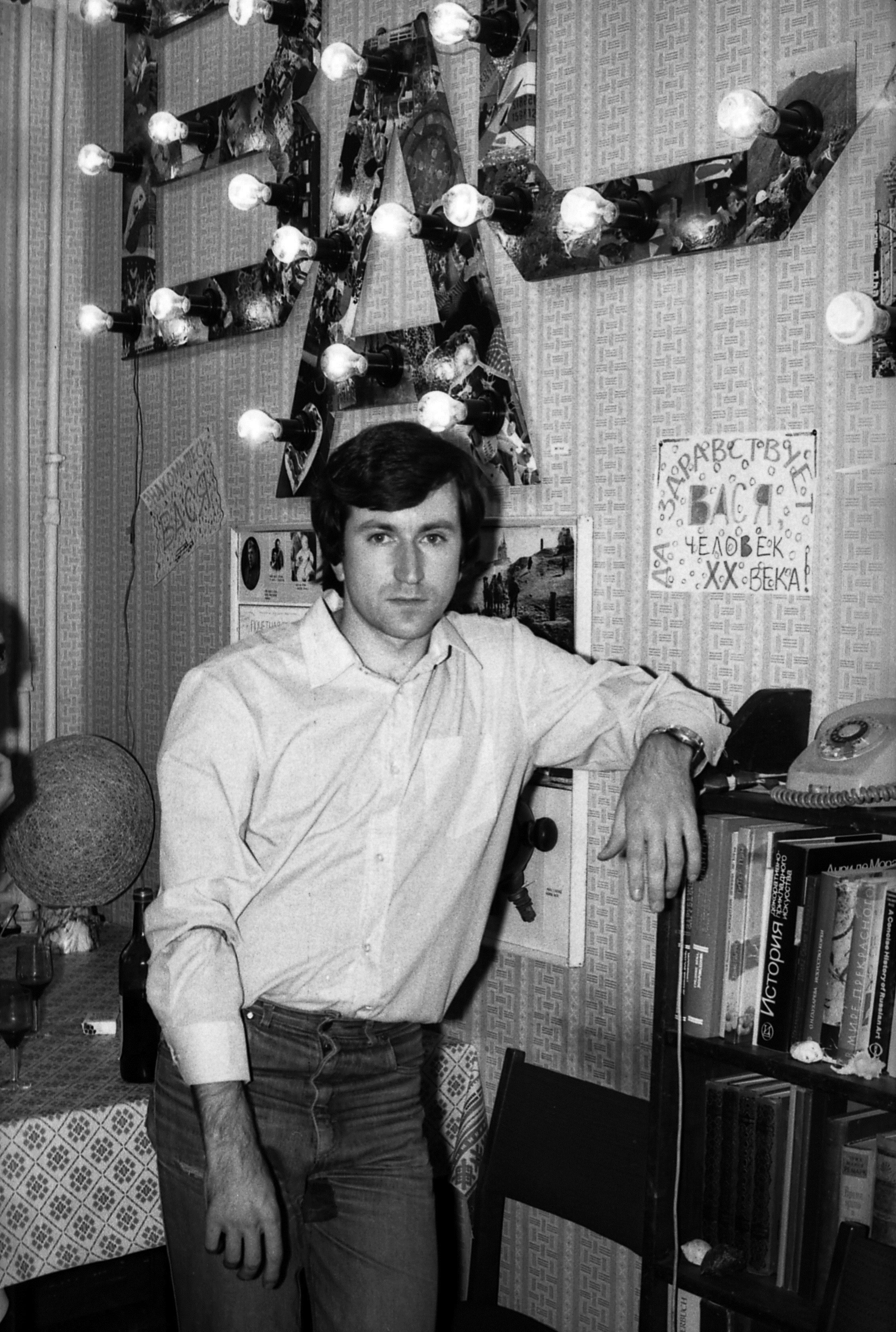 Georgе Kiesewalter at the opening of his exhibition Vasya’s Museum,
Georgе Kiesewalter at the opening of his exhibition Vasya’s Museum,
APTART Gallery. Moscow, 1983.
©George Kiesewalter
SO: Occasionally you appear in your own photographs, which means you would hand the camera over to someone.
GK: It was this shared life activity, a continual “life on loan.” I look at the negatives from 1974–1975 and sometimes I laugh. For example, Nikita Alexeev is photographed standing with his work Circles (1974), but then there are some shots where everyone takes their turn to be photographed next to Nikita's circles. It's not clear why. Back then it seemed very important or somehow stylish.
SO: How did the photographic series mentioned above come about: the ones taken shot in studios; Love Me, Love My Umbrella; and the Russia House series[16] of communal apartments and staircases?
GK: Around the Studios arose from working on MANI. From the end of 1980 I visited studios and photographed the artists' works for the MANI files. And I liked, as a rule, certain details in the studios that no one else paid any attention to. Of course, I hadn't been to some of the studios, I hadn't yet met everyone, but somehow I came up with this idea that interesting material was going to waste. It always seemed to me that you could only understand a work by hanging out with the artist and seeing how they worked, the atmosphere in the studio. At that time someone brought me a book about studios in New York. I took a look and thought “how are we any worse?” There was also this idea around at the time that our unofficial art would die off if it didn't find some outlet: the works would remain unshown, they would be dumped when the artist died, and so on. So I suggested to Vadim Zakharov that I would photograph the artists while he interviewed them. We started work. Once we'd shot everything I took some time off in order to print 12 (!) copies of all the photographs. Love me, Love my Umbrella came later, when I decided that I should make portraits of the artists. I'd just read James Joyce’s story Giacomo Joyce, and I liked the concluding phrase which served as a title, as a unifying idea for a shoot with some everyday object. I decided to photograph everyone with umbrellas. They became a hidden symbol for art.
SO: But the dramaturgy was established by the owners of the umbrellas?
GK: To an extent. For example, I took Erik Bulatov to VDNKh.[17] Everyone was amazed that Erik agreed to go somewhere. I took Vladimir gertz out of town.
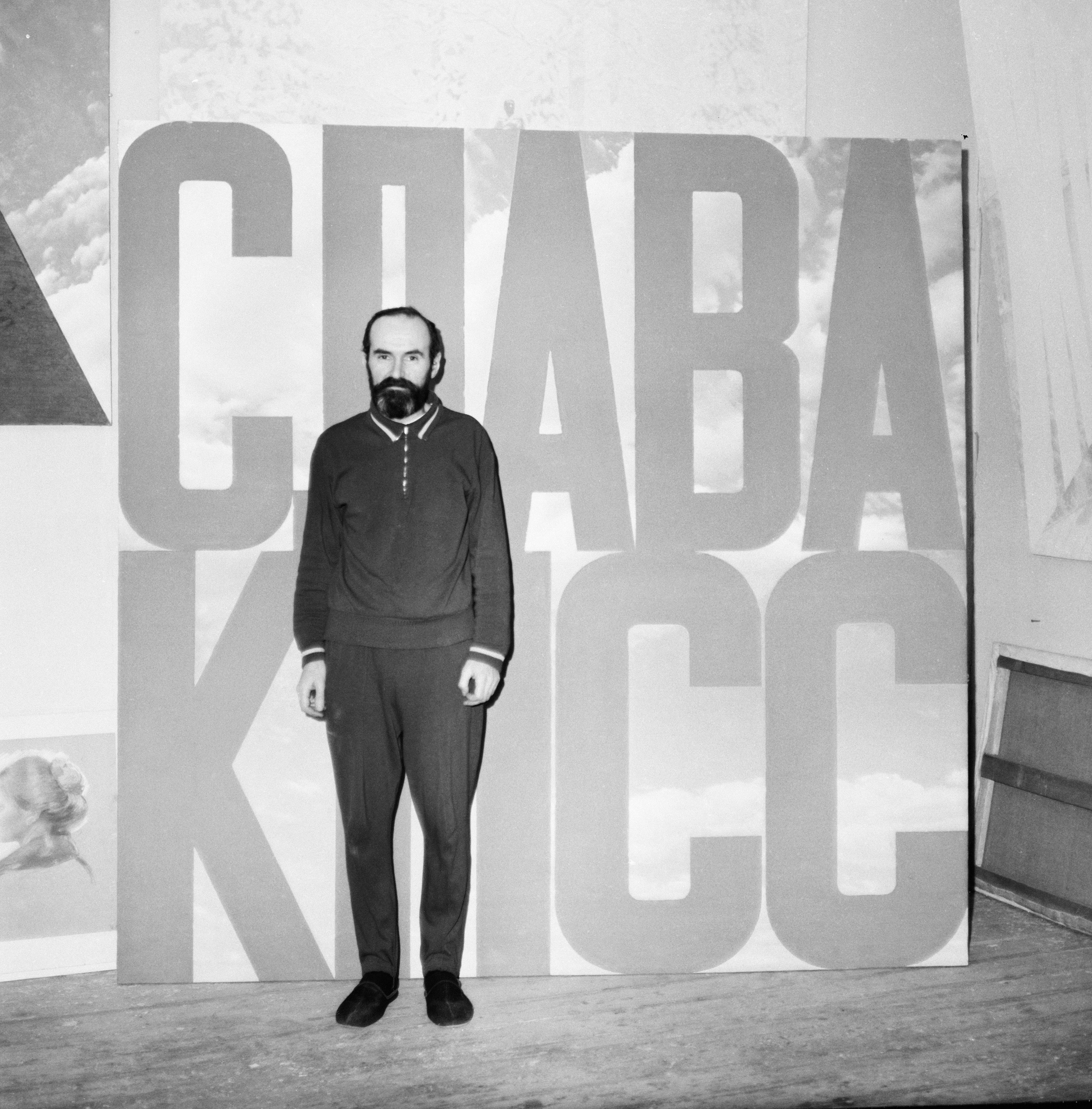 Erik Bulatov in his studio. Moscow, 1981
Erik Bulatov in his studio. Moscow, 1981
© George Kiesewalter
SO: And Monastyrsky in glasses—which he didn't wear back then—with dumb-bells, in a coat. Did he come up with that?
GK: I don't remember the details, but I think that was done spontaneously by Monastyrsky. Andrei always loved overcoats (the literary allusions to Chekhov are obvious[18]). The shoot took place at home, and then we just used whatever came to hand. I wasn't very interested in the entourage. Artists had to have an umbrella, but beyond that they could do whatever they wanted. I asked those who could to “tailor” their own umbrellas. Francisco Infante stuck aluminum foil round his. There was no Sugary Kremlin yet,[19] but the deconstruction of the language of power was already underway in Sorokin's stories, and so that's where the background came from. With the communal apartments, at first it turned out a little made to order. I lived in a communal apartment, as many of us did, and one time I shot something in my apartment. I showed it to Ilya Kabakov, who often visited me and knew that apartment. He asked me to continue that shoot for him, and I started going to other places, shooting communal apartments, old buildings, stairways. Those shots were used in the album-installation Olga Georgievna, Something is Boiling!,[20] and then in the design of the book Ten Characters.[21] Maybe Ilya used them somewhere else, in other installations. It all started in 1984–1985, then Kabakov emigrated, but I carried on shooting that series into the 1990s, for myself.
SO: Let's go back to the album Around the Studios. So you immediately agreed it all with Vadim Zakharov and went to shoot, or did you first shoot the project and then decide to make a book?
GK: It was all shot especially for the project. Although I had already shot at Bulatov's, Kabakov's, Vassiliev's, and Chuikov's previously, I'd photographed their works for the most part, or there were chance shots where they were sitting around or doing something, but I shot those without any particular aim. Now I started visiting them, for the most part with Vadim, so this was a series that was specially shot. Some of my previous material fitted the series, so certain shots were made earlier, in 1980–1981. I took the photographs, and Zakharov did the interviews and created the design. Vadim wasn't allowed into certain studios, because in one of his works he was dismissive of the Nonconformists,[22] and I had to fill in for him. Erik Bulatov refused to be present during his visit. Later everyone somehow made up.
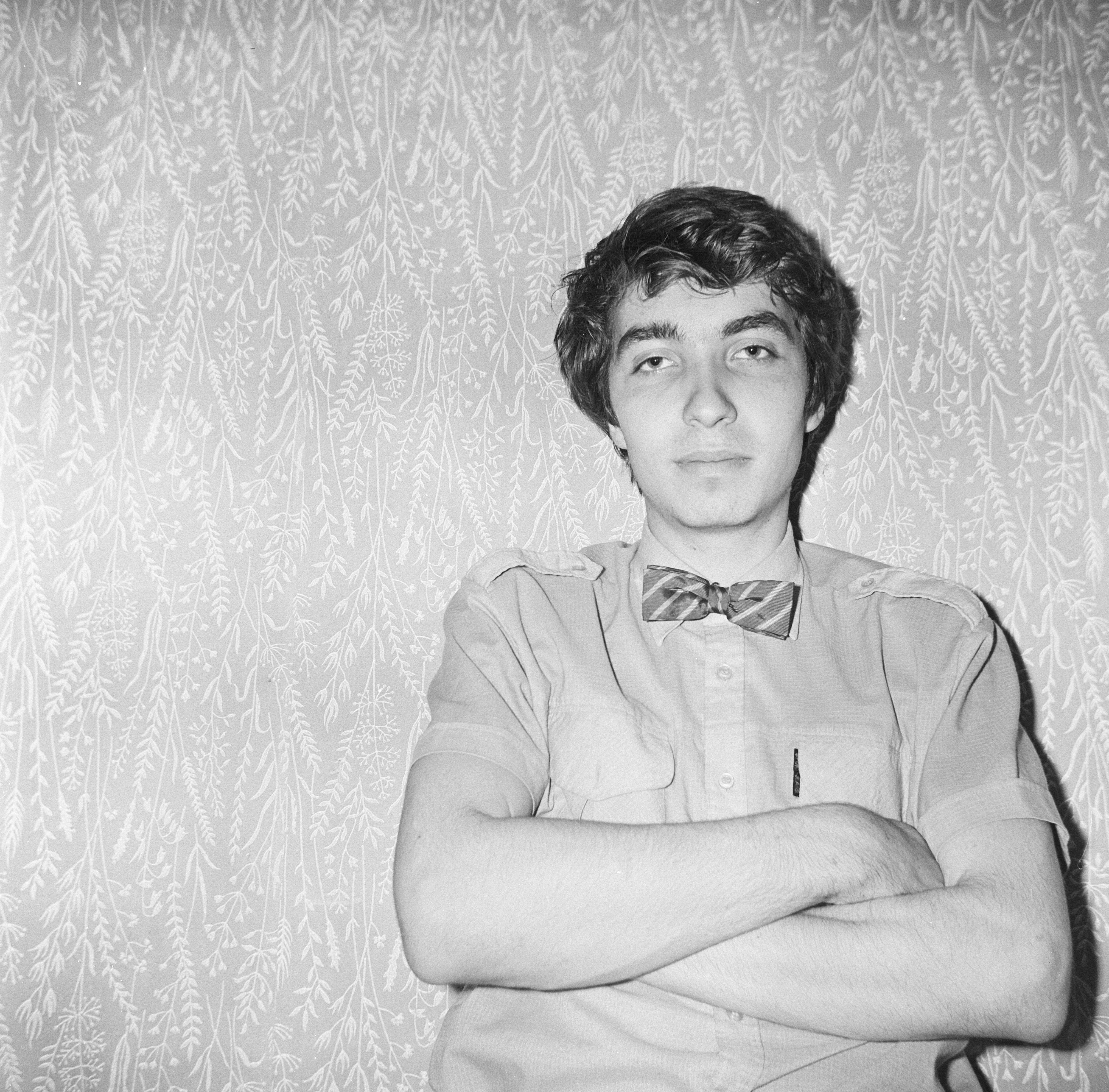 Vadim Zakharov. Moscow, 1982
Vadim Zakharov. Moscow, 1982
© George Kiesewalter
SO: Moscow artists of the 1960s are known through Igor Palmin’s portraits. His photographs have iconic status. Your photographs moved from the albums Around the Studios to the catalogue of the exhibition I Live – I See.[23] Having created your own "iconostasis" of the heroes of a generation, you stopped shooting at the point when the relative freedom of the perestroika period was replaced by strict market mechanisms. Why?
GK: In the 1990s I shot far less often. A lot more photographers appeared at that time. I understood that the time had come to change something in my life. The artists who I'd served so long and diligently, in essence, used my work, and then forgot about it. They didn't even reference me. I'd already got tired of that. I started to focus more on my own work, and that meant that I had less time and energy left over for photography. Now, looking back at those three decades, I can see that for me the most interesting time was the 1970s and 1980s. I sensed that the 1990s were simply a different time, with a different inter-relationship between artists, a different spirit, different institutions. Everything started to meld into a single field, an indistinguishable picture. That's when I began to archive myself, I began to sort through my family archive. The 1970s and the 1980s were my most active period, and the documentation of that period turned out to be the most fertile and, no doubt, the most interesting for posterity.
March 18, 2015
[1] The writer Anastasia Tsvetaeva (1894—1993) was the younger sister of poet Marina Tsvetaeva.
[2] Evgenia Zavadskaya (1930—2002) was an art historian who specialized in China and Japan.
[3] Thomas Mann’s novel The Magic Mountain had a cult following among the Conceptual artists who were part of Collective Actions group.
[4] Alexandre Rabinovitch-Barakovsky (b.1945) is a Russian-born minimalist composer and conductor. He emigrated from the Soviet Union in 1974, and now lives in Switzerland.
[5] Poet Lev Rubinstein would perform his work using a pack of library catalogue cards, each with a single line or phrase written on it. Having read a card he would turn it over on the table.
[6] Evgeny Shiffers (1934-1997) was a writer, director and religious philosopher who was friendly with many of the nonconformist artists.
[7] In the 1970s and 1980s, doctor and collector Alexander Chachko (b.1947) was friends with many of the nonconformist artists. In his room in a central Moscow communal apartment Chachko organized philosophy seminars and poetry readings, which were very popular with the unofficial art community. He emigrated to Israel in 1990.
[8] An exhibition of work by 145 nonconformist artists took place at the House of Culture at the Exhibition of National Economic Achievements (VDNKh), September 20—30, 1975.
[9] The first edition of the Moscow Archive of New Art (MANI) was published in samizdat (self-published) in an edition of four in February 1981. The folder included 12 texts—both manuscript and typewritten—and 22 envelopes with photographs or original artworks. The compiler of the first folder was Andrei Monastyrsky. The majority of the photographs were shot and printed by George Kiesewalter.
[10] Appearance took place on March 13, 1976 in Izmailovo Park, Moscow. It involved Andrei Monastyrsky, Lev Rubinstein, Nikita Alexeev, and George Kiesewalter.
[11] Lieblich was the second action in the series Trips Out of Town. It took place on April 2, 1976 at Izmailovskoe Field, near Moscow. The action involved Andrei Monastyrsky, Nikita Alexeev and George Kiesewalter.
[12] Andrei Monastyrsky, “Sem’ fotografii,” in Kollektivnye deistviya. Poezdki za gorod (Moscow: Ad Marginem, 1998), 189-193.
[13]Insider, an exhibition of George Kiesewalter’s photographs, took place at Garage Museum of Contemporary Art, June 12–August 23, 2015.
[14] This refers to the exhibition La nuova arte sovietica. Una prospettiva non ufficiale, also known as the Biennale of Dissent. It took place out of season, between regular biennales, in the Palazzetto della sport all’Arsenale, from November 15 to December 15, 1977. The curators were Enrico Crispolti and Gabriella Moncada.
[15] This one-day exhibition took place on September 25, 1983 in the yard of Vladimir and Sergei Mironenko’s dacha in the village of Tarasovka, Moscow region.
[16] Ilya Kabakov’s studio was in the attic of the Russia Insurance Corporation building at 6/1 Sretensky Boulevard, Moscow.
[17] One of Erik Bulatov’s best-known paintings, Welcome, features the Friendship of Nations fountain at VDNKh.
[18] This refers to Anton Chekhov’s short story The Man in a Case.
[19] Vladimir Sorokin’s book of short stories, Sugary Kremlin, was published in 2008 by ACT; Astrel, Moscow.
[20] This work is extensively reproduced and described in the Museu Serralves catalogue Verbal Photography and the Moscow Archive of New Art (2004).
[21] Ilya Kabakov, Ten Characters (London: ICA, 1989).
[22] This refers to a series of staged photographs by Vadim Zakharov, Inscriptions on Hand (1982).